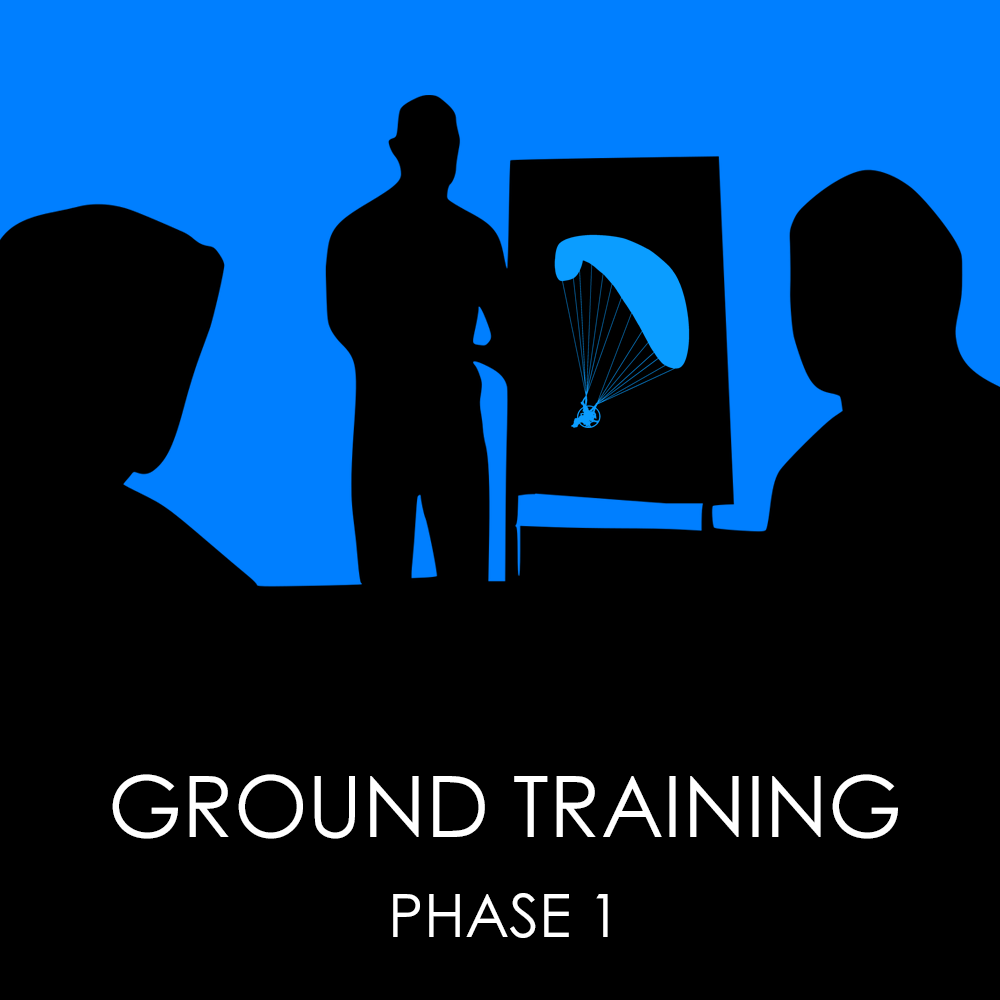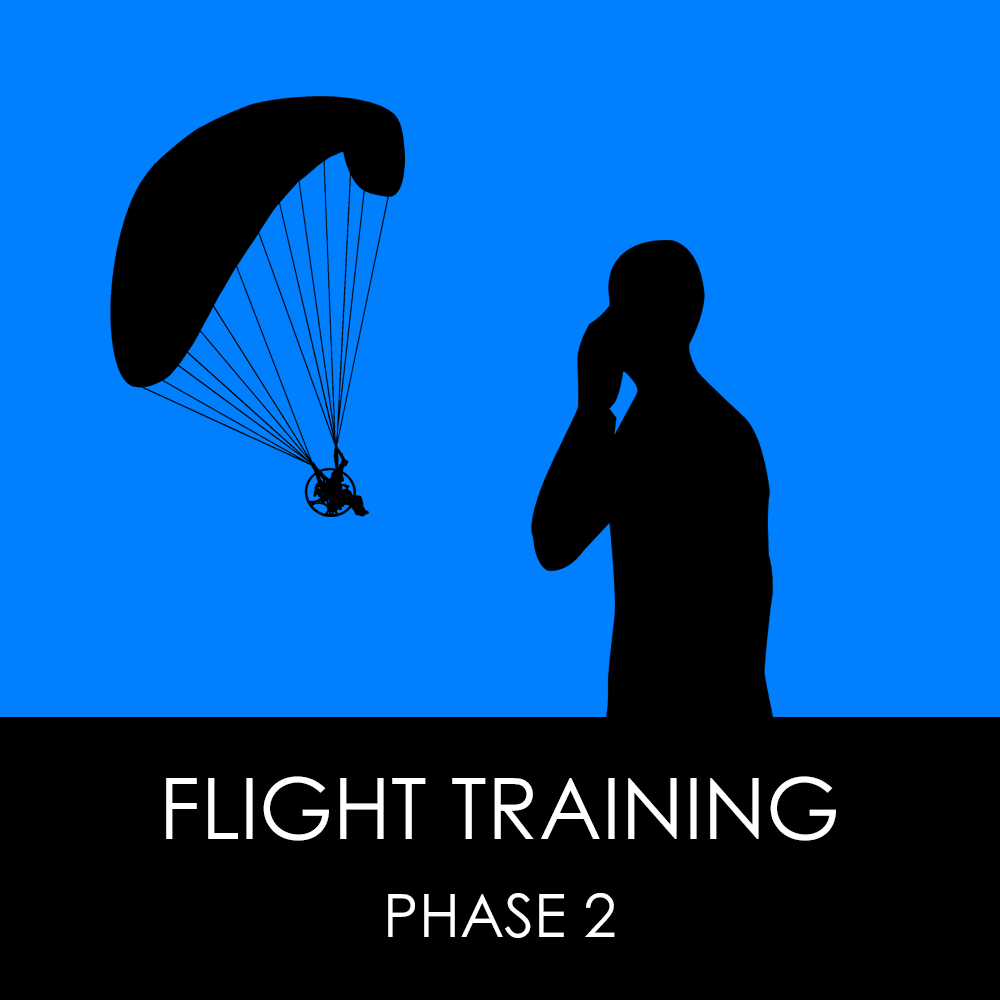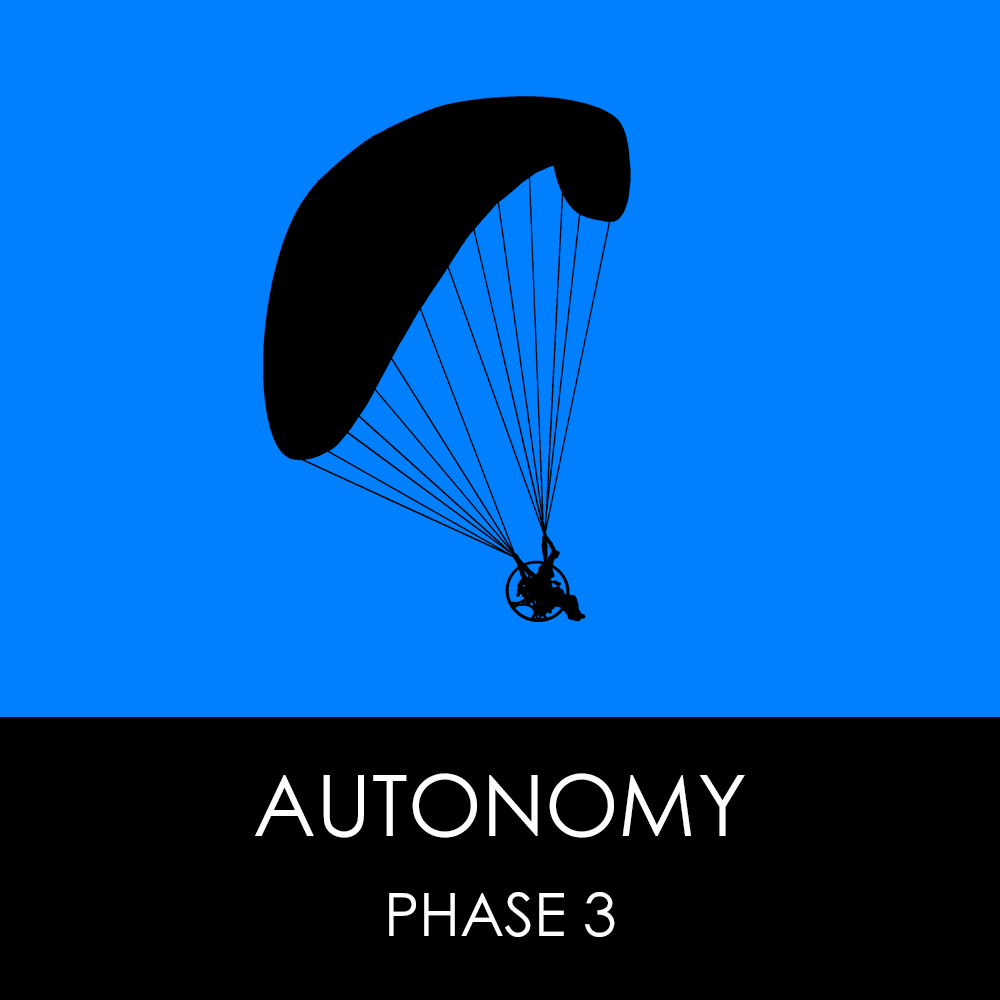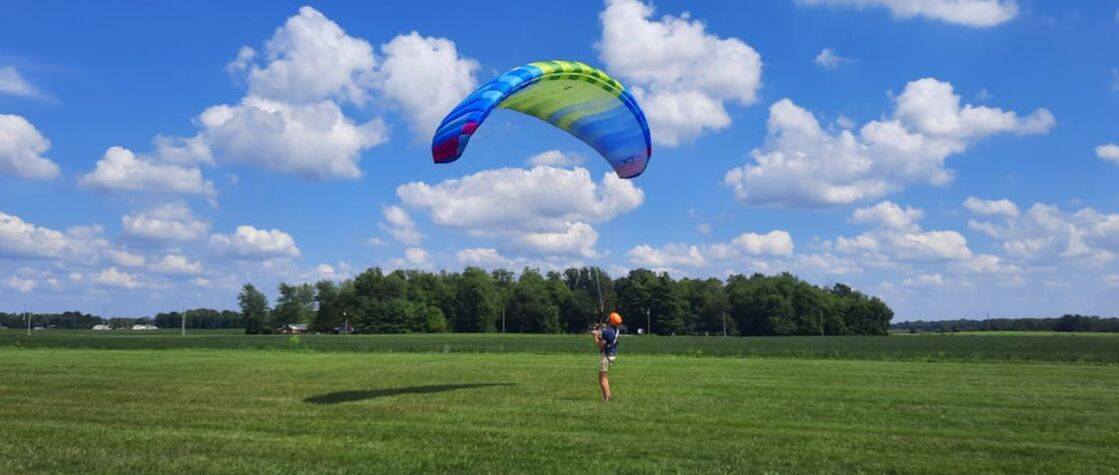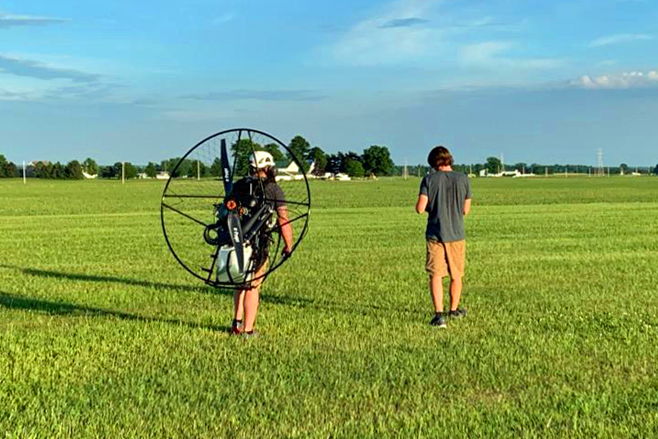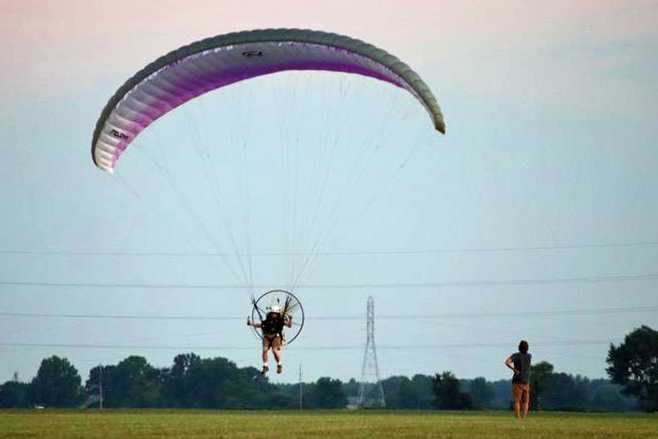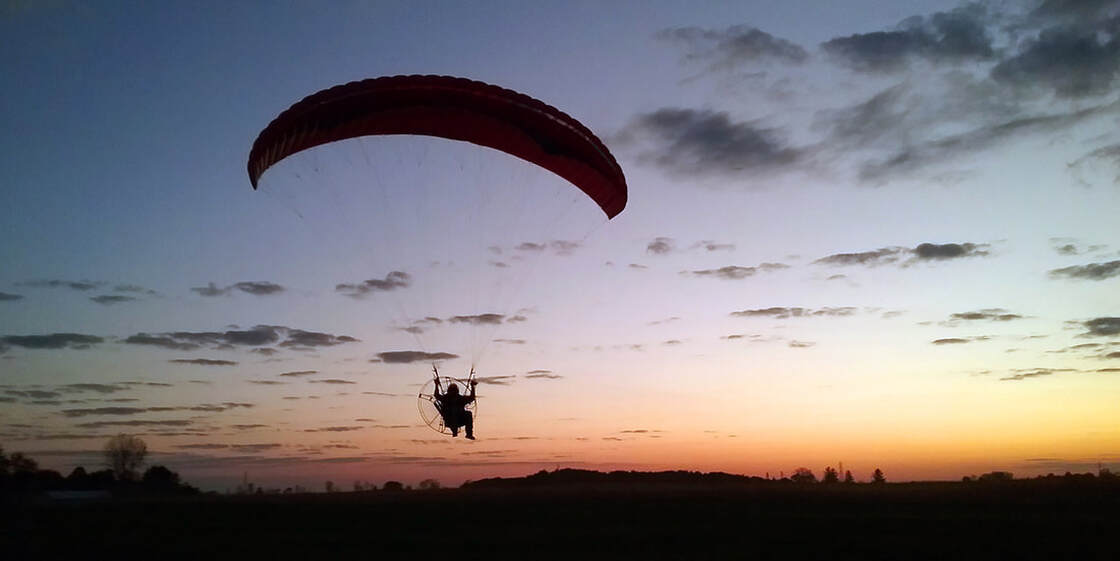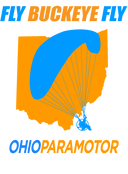About Paramotor Training
What is the Objective?
While safety is our primary concern, our objective is to teach you how to fly, not just get you in the air and give you an experience. This takes time. In fact, some of our best pilots work with us all season long. And that’s okay! We want you to leave a confident self-directed PPG pilot, one who knows how, where, and when to fly.
Are You a Certified School?
Yes, we are proud to be part of the United States Powered Paragliding Association (USPPA). As a certified school, we embrace the standards of the organization and the information it provides in the syllabi. We offer certified foot-launch instruction, and can offer the following USPPA ratings—PPG1, PPG2 and PPG3. Presently, however, we do not provide wheel-launch instruction, yet we'd be happy to recommend a wheel-launch school.
When is the Training Season?
While you may contact us any time you wish, we only train 6 months out of the year—May 1st through October 31st. These 6 months are completely full-on for us, as we train on a full-time basis, living and breathing this sport every day.
How Many Students Do You Accept?
As this is a wind and weather dependent sport (with limited flyable sessions each month), we believe in keeping things small. We limit our total enrollment for the season in our ground program and in our flight programs. This gives everyone lots of attention, plenty of time to work at their own pace, and ample space in the sky.
Can I Train Full or Part-time?
While concentrated training is best, we are flexible and don’t require or pressure our students to train on any specific day or set of days. You are free to make your own schedule and train at your own pace, coming out on a full or part-time basis. Part time training, however, does have its pitfalls. Our biggest concern: a student’s kiting /ground handling skills, as they are critical for development and future success.
What is Your Part-time Training Recommendation?
When you start training, come out to the field multiple days in a row. Once getting this foundation, we highly recommend that you talk to us and get yourself a glider. This will allow you to practice your kiting skills at home (after our approval) and will keep you moving forward without stagnation. Glider purchase is not mandatory at this time. Indeed, this sport is an investment. Ground handling, however, is by far the most time consuming activity during training and one of the most important aspects of PPG. A glider purchase is also money well spent. It will save you lots of time, gas money, and it should bring your overall training costs down as well. Kiting is also a lot of fun. And a glider does not have to break the bank. A kiting glider starts at around $1000 and a flyable glider starts at around $3000.
When Do Students Start?
New students start at the beginning of each month. Students are scheduled and have an official start date, often being established weeks to months in advance. This start date always takes place on a Saturday. Rain or shine, students are required to be present on this date. This gets everyone on the same page, particularly as it relates to technology and outlining ideal weather and training conditions.
How is Training Structured?
Students are in one of three phases. Phase 1 is ground training. Phase 2 is flight training and Phase 3 is about developing autonomy. While each phase is availability-based and payment-based, it is also performance-based. In short, each phase requires successful completion and approval. Just like any other course, you got to pass. For example, paying for Phase 1 / ground training does not guarantee Phase 2 / flight training. For your safety, we only move you forward when you are ready.
What is Phase 1 / Ground Training?
Phase 1 is our ground training. Ground training consists of coursework and fieldwork. The coursework (or ground school) addresses various USPPA concepts, information on safety, airspace, regulations, weather, wind, etc. The fieldwork is about a student’s physical development, the ground skills needed prior to flight training. For example, students learn how to properly ground handle (or kite) a paraglider in various winds, using various techniques, with the goal of acquiring automatic responses (muscle memory). The training window is large during Phase 1— much can be accomplished, as ground training can take place throughout the day. Once Phase 1 is successfully completed and there is availability, students can move into Phase 2.
What is Phase 2 / Flight Training?
Phase 2 is our flight training. Flight training is about developing all the physical and practical skills needed to fly a powered paraglider. Students learn how to launch, land, and fly. During Phase 2, students get direct, supervised instruction with in-flight communication (comms). Because PPG pilots don’t fly midday, evenings are dedicated to flight training–if and only when the conditions are good and flyable. Generally speaking, once a student enters Phase 2, they only come out on flyable evenings (yet are always welcome to come out during the day as well). On the first flight, students get more of an experience, an awakening to flight. Subsequent flights are more about development, about taking on more responsibility, as we focus on launches and landings. Keep in mind, the Phase 2 / flight training window is small. Students wait on flying conditions which do not materialize every evening. During Phase 2, students need lots of flexibility and commitment and must be willing to strike when conditions dictate. When students can launch, land and fly without direct instructor input, students can move to Phase 3 (availability dependent).
What is Phase 3 / Autonomy?
While we call Phase 3 Autonomy, this phase is really about practice and developing confidence. A familiar environment makes this quite ideal. During Phase 3, instruction is indirect and limited. Students are launching, landing and flying on their own, and developing their ability to assess conditions. Like Phase 2, the Phase 3 training window is small. Students wait on flying conditions and strike when the evenings are good and flyable. During Phase 3, confidence begins to shine and students generally start pondering other flying sites closer to home.
Can I Just Learn How to Kite / Ground Handle?
Yes, absolutely. This is actually one of the reasons we structured our training in this manner. While this sport is awesome, it’s not for everyone. And that’s okay! No pressure from us. And some of us do not have the means for the sport, but just want to get involved. That’s okay too! You are welcome to come in and only learn how to kite / ground handle a paraglider. Kiting is actually a lot of fun and great exercise as well. And if you change your mind in the future or have the funds to move into Phase 2 / flight training, you can easily do that as well. In fact, you will already possess so many kiting skills and probably go on to be an awesome pilot! Note: While kiting is fun, you need instruction before kiting on your own. If not, you will develop bad habits and it will take longer to learn PPG. More importantly, kiting can be dangerous. You really need to know what you’re doing.
How Do You Schedule A Training Session?
We have a student portal which has a booking application. Booking is based on the three phases of training. There is a Phase 1 booking, a Phase 2 booking and a Phase 3 booking. Upon scheduling, students and instructor receive an email confirmation. Students will learn more about the student portal on the first day of Phase 1 / Ground training.
What Does a Training Session Look Like?
Upon meeting at the designated day and time, we cater training to your individual needs while fulfilling various requirements. For example, if the wind is light during the day, Phase 1 students might be practicing forward inflations. And when students need a rest or if there are poor weather conditions, Phase 1 students will likely go over information or do other activities, such as working with the simulator. Of course, if the conditions are flyable that evening, Phase 2 students may be working on launches and landings while Phase 3 students may be working on airtime.
How Long Does Training Take?
Well, that’s really up to you, your commitment, your time, your development, and the weather. You, however, can train as much as you like, most days during Phase 1. On average, training takes about 14 days (Phase 1 and Phase 2). These are good weather days, not days in a row. If training takes more time or less time, that’s okay as well. We understand that people develop at different rates. We also understand that students have jobs, have family commitments, and are working at their own pace and with their own schedule.
May I Train on Gear Purchased Elsewhere?
No. You may only train on our gear or you may train on gear you purchased from us. This is the gear we trust. If, however, you purchased new or used gear from another company or individual, we will not fly you on it, nor will we support it. In short, you are on your own. Sadly, there is inferior and unsafe equipment out there (new and used). But there is quality gear out there as well, and we are always excited to try something new. This takes time, and we just don’t have that kind of time during the season. Some of this gear we come to believe in, some of it we do not. Lack of belief often stems from issues with support, design or quality. One thing is for certain: We don’t want our students to be test pilots. We want our students to be safe and successful, not dealing with gear problems after leaving our school.
What Are the Training Costs?
Because we structure our training into 3 phases, we also structure our costs into 3 phases. This allows students to work at their own pace, to pause training if need be, to take into account the unexpected things in life, not having to worry about unused training and associated payment. In addition, payment is by the month and is nonrefundable. If students want to continue training, they are billed at the end of the month. If payment is not received, an active student becomes a passive student. A passive student can always resume training at a later date (availability dependent). Note: Costs and training terms subject to change.
What is the Cost of Phase 1 / Ground Training?
Phase 1 costs $1500 for the first month, then $500 for each additional month. Sessions are available most days of the week and are available most times of the day (except flyable evenings as this time is devoted to Phase 2 students).
What is the Cost of Phase 2 / Flight Training?
Phase 2 costs $500 per month. Sessions lasts 2 hours and only takes place on flyable evenings.
What is the Cost for Phase 3 / Autonomy?
Phase 3 is free, if you purchased gear through us (paramotor and glider). If you need to use our gear, cost is $500 per month (availability dependent). Sessions lasts 2 hours and only takes place on flyable evenings.
Is There An Extra Training Cost to Use Our Gear?
There are no additional rental fees for Phase 1 or Phase 2. Your monthly cost includes instruction and access to all our gear, such as paramotors, gliders, helmets, etc. For Phase 3, if you are still using our gear, there is a rental fee of $500 per month. However, if you purchased a paramotor and glider through us, Phase 3 has no additional rental fees.
What Happens if I Break Something During Training?
If something is damaged during training, students are responsible. Generally, if something gets damaged, it is usually a propeller, a cost of around $300. Always remember: Run, run, run at launch, run far into the sky. Yes, you may drift down a bit at launch and you may need to run a little more.
Do You Do Training Refunds?
Weather limits this sport, and we limit our enrolment. This gives your spot value (it’s just for you). Except for the $500 deposit, we do not accept prepayment, such as paying $3000 upfront. Students pay by the month. As a result, all payments are nonrefundable. We want to earn our compensation and want students to feel value with our service. We also want to reward our students for their hard work, charging them less when they are dedicated to training.
Do You Sell Gear? And How Can I Get $500 Back?
Yes, we sell gear. And if you decide to buy a paramotor and glider from us (before, during or after training) you get a free month of training or we give you $500 back. If, however, you just want to buy a glider or paramotor (before, during or after training), we give you $250 back. Money back is tuition reimbursement. New gear (paramotor and glider) has a starting price of $8500 (around $5500 for a new paramotor and around $3000 for a new glider). We sell a variety of gear—Parajet, Miniplane, Fly Products, Ozone, BGD, Flow and more.
What Happens After Training or if Something Happens in Life?
At the end of training or if you need to take a break from training (yes, that is fine as well), a lack of payment moves you from an active student to a passive student. As a passive student, you are always able to schedule future instruction in Phase 1, Phase 2 or Phase 3 (availability dependent). Of course, if you are having issues with gear purchased through us, you can always get support from us. No matter if you are a passive student or an active student (in Phase 1, 2 or 3) if you ever have an issue, we want to hear from you.
How Do I Sign up?
If you want to sign up for training, you’ll first need to fill out the training questionnaire. Once we receive it, we’ll contact you. If everything sounds good and you want to move forward, we ask for a $500 deposit. This deposit officially secures your Phase 1 / ground training spot and gets you a start date. The deposit is nonrefundable, as we are saving the spot just for you.
Got a Question? Want to Know Our Availability?
If you have any questions about the above or want to know our availability, feel free to contact us. We’d be happy to assist you.
While safety is our primary concern, our objective is to teach you how to fly, not just get you in the air and give you an experience. This takes time. In fact, some of our best pilots work with us all season long. And that’s okay! We want you to leave a confident self-directed PPG pilot, one who knows how, where, and when to fly.
Are You a Certified School?
Yes, we are proud to be part of the United States Powered Paragliding Association (USPPA). As a certified school, we embrace the standards of the organization and the information it provides in the syllabi. We offer certified foot-launch instruction, and can offer the following USPPA ratings—PPG1, PPG2 and PPG3. Presently, however, we do not provide wheel-launch instruction, yet we'd be happy to recommend a wheel-launch school.
When is the Training Season?
While you may contact us any time you wish, we only train 6 months out of the year—May 1st through October 31st. These 6 months are completely full-on for us, as we train on a full-time basis, living and breathing this sport every day.
How Many Students Do You Accept?
As this is a wind and weather dependent sport (with limited flyable sessions each month), we believe in keeping things small. We limit our total enrollment for the season in our ground program and in our flight programs. This gives everyone lots of attention, plenty of time to work at their own pace, and ample space in the sky.
Can I Train Full or Part-time?
While concentrated training is best, we are flexible and don’t require or pressure our students to train on any specific day or set of days. You are free to make your own schedule and train at your own pace, coming out on a full or part-time basis. Part time training, however, does have its pitfalls. Our biggest concern: a student’s kiting /ground handling skills, as they are critical for development and future success.
What is Your Part-time Training Recommendation?
When you start training, come out to the field multiple days in a row. Once getting this foundation, we highly recommend that you talk to us and get yourself a glider. This will allow you to practice your kiting skills at home (after our approval) and will keep you moving forward without stagnation. Glider purchase is not mandatory at this time. Indeed, this sport is an investment. Ground handling, however, is by far the most time consuming activity during training and one of the most important aspects of PPG. A glider purchase is also money well spent. It will save you lots of time, gas money, and it should bring your overall training costs down as well. Kiting is also a lot of fun. And a glider does not have to break the bank. A kiting glider starts at around $1000 and a flyable glider starts at around $3000.
When Do Students Start?
New students start at the beginning of each month. Students are scheduled and have an official start date, often being established weeks to months in advance. This start date always takes place on a Saturday. Rain or shine, students are required to be present on this date. This gets everyone on the same page, particularly as it relates to technology and outlining ideal weather and training conditions.
How is Training Structured?
Students are in one of three phases. Phase 1 is ground training. Phase 2 is flight training and Phase 3 is about developing autonomy. While each phase is availability-based and payment-based, it is also performance-based. In short, each phase requires successful completion and approval. Just like any other course, you got to pass. For example, paying for Phase 1 / ground training does not guarantee Phase 2 / flight training. For your safety, we only move you forward when you are ready.
What is Phase 1 / Ground Training?
Phase 1 is our ground training. Ground training consists of coursework and fieldwork. The coursework (or ground school) addresses various USPPA concepts, information on safety, airspace, regulations, weather, wind, etc. The fieldwork is about a student’s physical development, the ground skills needed prior to flight training. For example, students learn how to properly ground handle (or kite) a paraglider in various winds, using various techniques, with the goal of acquiring automatic responses (muscle memory). The training window is large during Phase 1— much can be accomplished, as ground training can take place throughout the day. Once Phase 1 is successfully completed and there is availability, students can move into Phase 2.
What is Phase 2 / Flight Training?
Phase 2 is our flight training. Flight training is about developing all the physical and practical skills needed to fly a powered paraglider. Students learn how to launch, land, and fly. During Phase 2, students get direct, supervised instruction with in-flight communication (comms). Because PPG pilots don’t fly midday, evenings are dedicated to flight training–if and only when the conditions are good and flyable. Generally speaking, once a student enters Phase 2, they only come out on flyable evenings (yet are always welcome to come out during the day as well). On the first flight, students get more of an experience, an awakening to flight. Subsequent flights are more about development, about taking on more responsibility, as we focus on launches and landings. Keep in mind, the Phase 2 / flight training window is small. Students wait on flying conditions which do not materialize every evening. During Phase 2, students need lots of flexibility and commitment and must be willing to strike when conditions dictate. When students can launch, land and fly without direct instructor input, students can move to Phase 3 (availability dependent).
What is Phase 3 / Autonomy?
While we call Phase 3 Autonomy, this phase is really about practice and developing confidence. A familiar environment makes this quite ideal. During Phase 3, instruction is indirect and limited. Students are launching, landing and flying on their own, and developing their ability to assess conditions. Like Phase 2, the Phase 3 training window is small. Students wait on flying conditions and strike when the evenings are good and flyable. During Phase 3, confidence begins to shine and students generally start pondering other flying sites closer to home.
Can I Just Learn How to Kite / Ground Handle?
Yes, absolutely. This is actually one of the reasons we structured our training in this manner. While this sport is awesome, it’s not for everyone. And that’s okay! No pressure from us. And some of us do not have the means for the sport, but just want to get involved. That’s okay too! You are welcome to come in and only learn how to kite / ground handle a paraglider. Kiting is actually a lot of fun and great exercise as well. And if you change your mind in the future or have the funds to move into Phase 2 / flight training, you can easily do that as well. In fact, you will already possess so many kiting skills and probably go on to be an awesome pilot! Note: While kiting is fun, you need instruction before kiting on your own. If not, you will develop bad habits and it will take longer to learn PPG. More importantly, kiting can be dangerous. You really need to know what you’re doing.
How Do You Schedule A Training Session?
We have a student portal which has a booking application. Booking is based on the three phases of training. There is a Phase 1 booking, a Phase 2 booking and a Phase 3 booking. Upon scheduling, students and instructor receive an email confirmation. Students will learn more about the student portal on the first day of Phase 1 / Ground training.
What Does a Training Session Look Like?
Upon meeting at the designated day and time, we cater training to your individual needs while fulfilling various requirements. For example, if the wind is light during the day, Phase 1 students might be practicing forward inflations. And when students need a rest or if there are poor weather conditions, Phase 1 students will likely go over information or do other activities, such as working with the simulator. Of course, if the conditions are flyable that evening, Phase 2 students may be working on launches and landings while Phase 3 students may be working on airtime.
How Long Does Training Take?
Well, that’s really up to you, your commitment, your time, your development, and the weather. You, however, can train as much as you like, most days during Phase 1. On average, training takes about 14 days (Phase 1 and Phase 2). These are good weather days, not days in a row. If training takes more time or less time, that’s okay as well. We understand that people develop at different rates. We also understand that students have jobs, have family commitments, and are working at their own pace and with their own schedule.
May I Train on Gear Purchased Elsewhere?
No. You may only train on our gear or you may train on gear you purchased from us. This is the gear we trust. If, however, you purchased new or used gear from another company or individual, we will not fly you on it, nor will we support it. In short, you are on your own. Sadly, there is inferior and unsafe equipment out there (new and used). But there is quality gear out there as well, and we are always excited to try something new. This takes time, and we just don’t have that kind of time during the season. Some of this gear we come to believe in, some of it we do not. Lack of belief often stems from issues with support, design or quality. One thing is for certain: We don’t want our students to be test pilots. We want our students to be safe and successful, not dealing with gear problems after leaving our school.
What Are the Training Costs?
Because we structure our training into 3 phases, we also structure our costs into 3 phases. This allows students to work at their own pace, to pause training if need be, to take into account the unexpected things in life, not having to worry about unused training and associated payment. In addition, payment is by the month and is nonrefundable. If students want to continue training, they are billed at the end of the month. If payment is not received, an active student becomes a passive student. A passive student can always resume training at a later date (availability dependent). Note: Costs and training terms subject to change.
What is the Cost of Phase 1 / Ground Training?
Phase 1 costs $1500 for the first month, then $500 for each additional month. Sessions are available most days of the week and are available most times of the day (except flyable evenings as this time is devoted to Phase 2 students).
What is the Cost of Phase 2 / Flight Training?
Phase 2 costs $500 per month. Sessions lasts 2 hours and only takes place on flyable evenings.
What is the Cost for Phase 3 / Autonomy?
Phase 3 is free, if you purchased gear through us (paramotor and glider). If you need to use our gear, cost is $500 per month (availability dependent). Sessions lasts 2 hours and only takes place on flyable evenings.
Is There An Extra Training Cost to Use Our Gear?
There are no additional rental fees for Phase 1 or Phase 2. Your monthly cost includes instruction and access to all our gear, such as paramotors, gliders, helmets, etc. For Phase 3, if you are still using our gear, there is a rental fee of $500 per month. However, if you purchased a paramotor and glider through us, Phase 3 has no additional rental fees.
What Happens if I Break Something During Training?
If something is damaged during training, students are responsible. Generally, if something gets damaged, it is usually a propeller, a cost of around $300. Always remember: Run, run, run at launch, run far into the sky. Yes, you may drift down a bit at launch and you may need to run a little more.
Do You Do Training Refunds?
Weather limits this sport, and we limit our enrolment. This gives your spot value (it’s just for you). Except for the $500 deposit, we do not accept prepayment, such as paying $3000 upfront. Students pay by the month. As a result, all payments are nonrefundable. We want to earn our compensation and want students to feel value with our service. We also want to reward our students for their hard work, charging them less when they are dedicated to training.
Do You Sell Gear? And How Can I Get $500 Back?
Yes, we sell gear. And if you decide to buy a paramotor and glider from us (before, during or after training) you get a free month of training or we give you $500 back. If, however, you just want to buy a glider or paramotor (before, during or after training), we give you $250 back. Money back is tuition reimbursement. New gear (paramotor and glider) has a starting price of $8500 (around $5500 for a new paramotor and around $3000 for a new glider). We sell a variety of gear—Parajet, Miniplane, Fly Products, Ozone, BGD, Flow and more.
What Happens After Training or if Something Happens in Life?
At the end of training or if you need to take a break from training (yes, that is fine as well), a lack of payment moves you from an active student to a passive student. As a passive student, you are always able to schedule future instruction in Phase 1, Phase 2 or Phase 3 (availability dependent). Of course, if you are having issues with gear purchased through us, you can always get support from us. No matter if you are a passive student or an active student (in Phase 1, 2 or 3) if you ever have an issue, we want to hear from you.
How Do I Sign up?
If you want to sign up for training, you’ll first need to fill out the training questionnaire. Once we receive it, we’ll contact you. If everything sounds good and you want to move forward, we ask for a $500 deposit. This deposit officially secures your Phase 1 / ground training spot and gets you a start date. The deposit is nonrefundable, as we are saving the spot just for you.
Got a Question? Want to Know Our Availability?
If you have any questions about the above or want to know our availability, feel free to contact us. We’d be happy to assist you.

